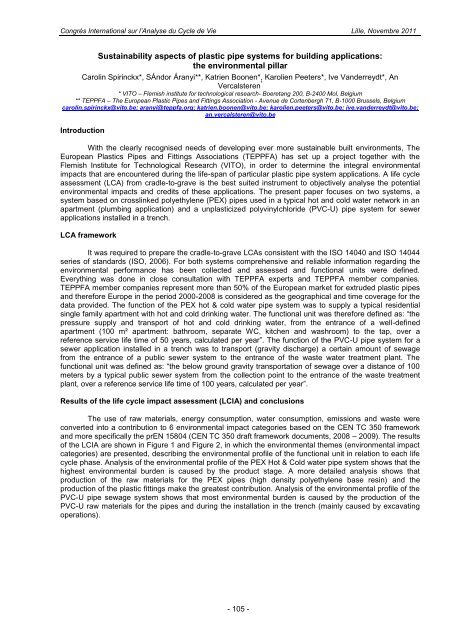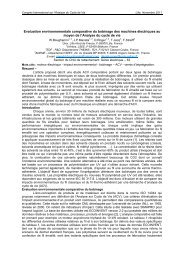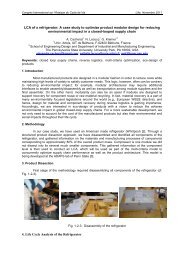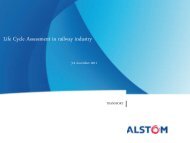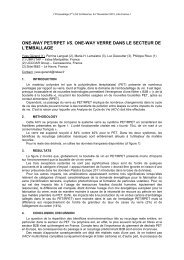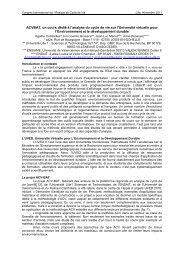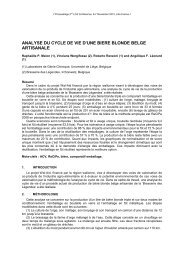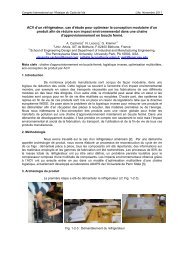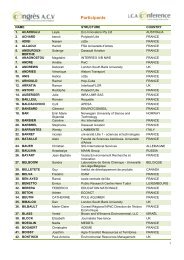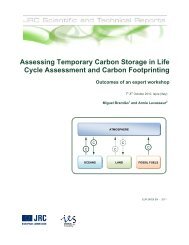Untitled - avniR
Untitled - avniR
Untitled - avniR
You also want an ePaper? Increase the reach of your titles
YUMPU automatically turns print PDFs into web optimized ePapers that Google loves.
Congrès International sur l’Analyse du Cycle de Vie Lille, Novembre 2011<br />
Sustainability aspects of plastic pipe systems for building applications:<br />
the environmental pillar<br />
Carolin Spirinckx*, SÁndor Áranyi**, Katrien Boonen*, Karolien Peeters*, Ive Vanderreydt*, An<br />
Vercalsteren *<br />
* VITO – Flemish institute for technological research- Boeretang 200, B-2400 Mol, Belgium<br />
** TEPPFA – The European Plastic Pipes and Fittings Association - Avenue de Cortenbergh 71, B-1000 Brussels, Belgium<br />
carolin.spirinckx@vito.be; aranyi@teppfa.org; katrien.boonen@vito.be; karolien.peeters@vito.be; ive.vanderreydt@vito.be;<br />
an.vercalsteren@vito.be<br />
Introduction<br />
With the clearly recognised needs of developing ever more sustainable built environments, The<br />
European Plastics Pipes and Fittings Associations (TEPPFA) has set up a project together with the<br />
Flemish Institute for Technological Research (VITO), in order to determine the integral environmental<br />
impacts that are encountered during the life-span of particular plastic pipe system applications. A life cycle<br />
assessment (LCA) from cradle-to-grave is the best suited instrument to objectively analyse the potential<br />
environmental impacts and credits of these applications. The present paper focuses on two systems, a<br />
system based on crosslinked polyethylene (PEX) pipes used in a typical hot and cold water network in an<br />
apartment (plumbing application) and a unplasticized polyvinylchloride (PVC-U) pipe system for sewer<br />
applications installed in a trench.<br />
LCA framework<br />
It was required to prepare the cradle-to-grave LCAs consistent with the ISO 14040 and ISO 14044<br />
series of standards (ISO, 2006). For both systems comprehensive and reliable information regarding the<br />
environmental performance has been collected and assessed and functional units were defined.<br />
Everything was done in close consultation with TEPPFA experts and TEPPFA member companies.<br />
TEPPFA member companies represent more than 50% of the European market for extruded plastic pipes<br />
and therefore Europe in the period 2000-2008 is considered as the geographical and time coverage for the<br />
data provided. The function of the PEX hot & cold water pipe system was to supply a typical residential<br />
single family apartment with hot and cold drinking water. The functional unit was therefore defined as: “the<br />
pressure supply and transport of hot and cold drinking water, from the entrance of a well-defined<br />
apartment (100 m² apartment: bathroom, separate WC, kitchen and washroom) to the tap, over a<br />
reference service life time of 50 years, calculated per year”. The function of the PVC-U pipe system for a<br />
sewer application installed in a trench was to transport (gravity discharge) a certain amount of sewage<br />
from the entrance of a public sewer system to the entrance of the waste water treatment plant. The<br />
functional unit was defined as: “the below ground gravity transportation of sewage over a distance of 100<br />
meters by a typical public sewer system from the collection point to the entrance of the waste treatment<br />
plant, over a reference service life time of 100 years, calculated per year”.<br />
Results of the life cycle impact assessment (LCIA) and conclusions<br />
The use of raw materials, energy consumption, water consumption, emissions and waste were<br />
converted into a contribution to 6 environmental impact categories based on the CEN TC 350 framework<br />
and more specifically the prEN 15804 (CEN TC 350 draft framework documents, 2008 – 2009). The results<br />
of the LCIA are shown in Figure 1 and Figure 2, in which the environmental themes (environmental impact<br />
categories) are presented, describing the environmental profile of the functional unit in relation to each life<br />
cycle phase. Analysis of the environmental profile of the PEX Hot & Cold water pipe system shows that the<br />
highest environmental burden is caused by the product stage. A more detailed analysis shows that<br />
production of the raw materials for the PEX pipes (high density polyethylene base resin) and the<br />
production of the plastic fittings make the greatest contribution. Analysis of the environmental profile of the<br />
PVC-U pipe sewage system shows that most environmental burden is caused by the production of the<br />
PVC-U raw materials for the pipes and during the installation in the trench (mainly caused by excavating<br />
operations).<br />
- 105 -


